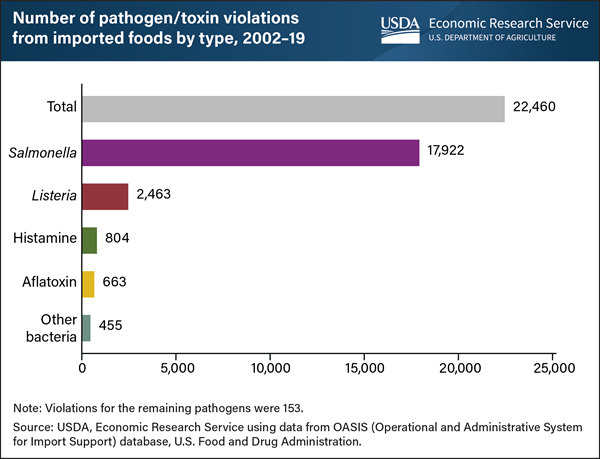The USDA Economic Research Service (ERS) study studied the number of U.S. import refusals caused by pathogen/toxin contamination and which pathogens accounted for those safety violations. From 2002 to 2019, 22,460 pathogen/toxin violations were discovered among imported shipments. Salmonella was the most frequently identified agent among imported foods during the period with 80%, or 17,922 of total violations. Listeria recorded the second largest number of violations at 2,463, accounting for 11%. It was followed by histamine with 804 violations (3.6%), aflatoxin with 663 violations (3%), and bacteria other than Salmonella or Listeria with 455 violations (2%). The five most frequently detected pathogens and toxins accounted for 99.3% of the total violations from imported foods. @ https://www.ers.usda.gov/data-products/chart-gallery/gallery/chart-detail/?chartId=103529#:~:text=Salmonella%20accounted%20for%20nearly%2080,illness%20risks%20for%20U.S.%20consumers
Salmonella accounted for around 80% of pathogen violations in U.S. food imports from 2002 to 2019
As the quantity of food imported into the United States continues to rise, it is increasingly important to minimize foodborne illness risks for U.S. consumers. Foods contaminated with pathogens or toxins can result in foodborne illnesses. A recent USDA, Economic Research Service (ERS) study examined the number of U.S. import refusals caused by pathogen/toxin contamination and which pathogens accounted for those safety violations. From 2002 to 2019, 22,460 pathogen/toxin violations were discovered among imported shipments. Salmonella was the most frequently identified agent among imported foods during the period with 80 percent, or 17,922 of total pathogen/toxin violations. Listeria recorded the second largest number of violations at 2,463, accounting for 11 percent of the total. It was followed by histamine with 804 violations (3.6 percent), aflatoxin with 663 violations (3 percent), and bacteria other than Salmonella or Listeria with 455 violations (2 percent). Those five most frequently detected pathogens and toxins accounted for 99.3 percent of the total pathogen/toxin violations from imported foods over the period. This chart was drawn from the ERS report Examining Pathogen-Based Import Refusals: Trends and Analysis From 2002 to 2019, published December 2021.

